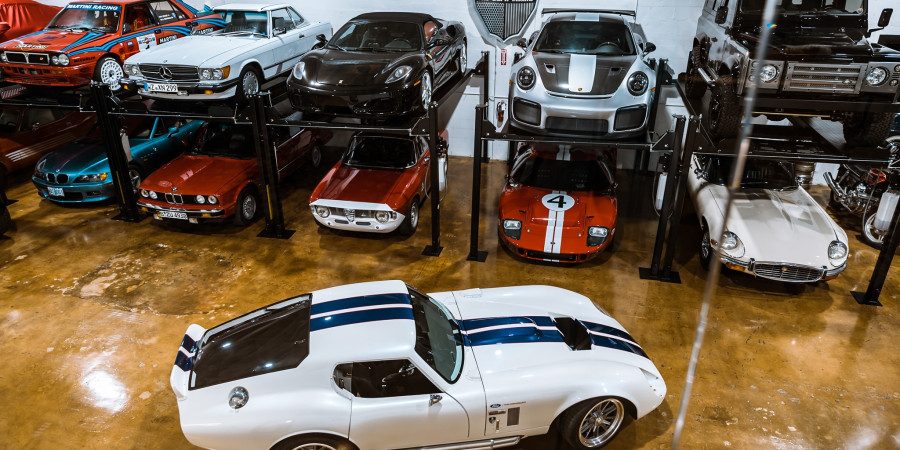Most luxury car collections evolve organically. One car becomes three, and then all of a sudden there are twelve or twenty; often stored in different places, countries, or even continents. Very few luxury car owners buy cars thinking that they’re building a ‘collection’. Fewer, if any, start with a blueprint, a plan, or even an analysis of the resources needed to care for and curate an important collection.
While it may sound Bond-esque to some to have a collection strewn across the world ready for use wherever one lands, to an EM, it sounds like an asset-tracking ‘challenge’ (I’m being nice here). With a little planning, however, and implementation of systems, a collection of fine autos can be easily maintained and managed.
Let’s consider the main items that should be handled from the start, or retroactively put in place to formalize the collection:
Ownership Structure – How the cars are owned is important. They can be owned in the principal’s own name, in a family trust, a company, or a special purpose entity. It’s worth thinking about any tax implications of the collection (gains, inheritance…), where the cars are garaged (insurance, registration fees…), and how they are used (pleasure, work, by staff…) to best negotiate the ownership structure.
In many cases, setting up a simple LLC to own the cars can make sense to ensure that assets are protected separately from the principal’s primary assets and shielded from creditors or litigious actors in the event of an accident. For more valuable cars, or cars that are intended for trade or auction, it might make sense to set up an LLC per car.
Documentation – A sale of a great car with all books, receipts, notes & records ordered with fastidious attention to detail will achieve a better price than the same car with records that are lacking detail or paperwork. The story of the car is told through its records; its history & its provenance must be well-documented.
Keep hard copies and digital backups of all sales and shipping records, maintenance and repairs, upgrades and modifications. It’s also good to keep a record of races, showings, or events the car has participated in. In some circles, high profile or celebrity owners and drivers add value, so track those as well, if you can.
Valuation – Luxury car values are fluid and heavily dependent on a myriad of factors. We mentioned provenance; who built, delivered, handled, owned, and / or drove the car has value. We talked about history; significant events surrounding the car’s design and use add (or detract from) its value. Scarcity in the marketplace is also a top factor of value.
Appraisals are a must. You’ll want to find an appraiser who specializes in your specific cars, which may mean you will engage several appraisal companies. Someone who specializes in European high-performance vehicles may miss some value in a vintage American muscle car. You may find one company that employs several specialists; that’s a good find and it’s worth using that kind of company for consistency of appraisal reports and ease of retrieving information.
We’d suggest tracking a few numbers for each car so that you are always on point when it comes to future trading. You should know the quick sale price, a patient sale price, and a not for sale price.
Insurance – Once you know the value of the collection, it needs to be properly insured. It’s tempting to get a blanket or portfolio policy that covers everything, but this is another example of when specialization matters. A 2022 Bugatti should be insured differently than a 1966 Corvette Stingray. Replacement value, salvage value, and restoration are viewed completely differently in a new car as opposed to a vintage auto.
You’ll have the best luck working with a broker who can cull together the different specialty insurance policies that may be needed to cover the collection. We recommend a company like Haggerty as a one-stop-shop. At the very least, cover each car by an insurance company based in the country where the car is garaged. The more local the company, the more likely you’ll receive quick and thorough service when needed.
Storage – We recommend storage solutions based on usage; keeping daily drives close at hand in a residential garage and race or show cars in a secure offsite storage facility or the mechanic’s warehouse. There is a new trend of storage clubs popping up across the US as well. They provide a unique opportunity to socialize with other car collectors while keeping your collection safe. Some even have tracks. See Luxury Car Storage for more on that option.
Security – When cars are not garaged, they are vulnerable to theft. There are few things that you can do to deter thieves, however, starting with installing top-level anti-theft devices and ensuring that the details are displayed in your car windows. Many thieves are opportunists looking for a quick result, and the longer it takes them to steal a car, the less likely they are to try. An electronic engine immobilizer is one of the most secure devices, especially when coupled with an alarm. You could also consider tracking devices so that, in the worst-case scenario, it may be possible to track down a vehicle.
Transportation – Wear and tear affect the value of a car. If your principal is going more than a day’s drive, consider shipping the car. There are a number of luxury car transport companies who will ship door to door in a covered trailer. Ask fellow car enthusiasts for their recommendations, and ask the companies you’re vetting for their references.
Servicing & Maintenance – As previously mentioned, fastidious record-keeping is key to maximizing the value of a collectable car. It’s important to show that essential maintenance and service targets have been met on time, and the work performed by reputable service providers. If there is any warranty on the vehicle, be sure to utilize factory authorized providers and require factory parts. If it’s not under warranty, find a mechanic who specializes in your specific car(s). For example, our friends at Issimi Mechanica specialize in high performance vehicles with an exclusive Ferrari team on-site. In addition to routine care, they have a collection management program and a full restoration workshop.
Keeping Track of it All – Spreadsheets are fine, but you really need an asset management system that accommodates scanned documents, photos, and receipts. An inventory system like Encircle is a great choice, and widely accepted by insurance companies for claims. A more complex system like EstateSpace can integrate a car collection with other assets and properties.
Ultimately, successfully managing a collection of luxury cars is about relationships and record keeping. It is a big world but a small circle. Find the people who know the guy who does…… whatever you need. Keep their numbers. Send them holiday cards. Ask for help when you need it. A principal’s cars may be the most valuable collection they have, both financially and emotionally. Leave what you can to the experts and do a good job of tracking all of the details.



